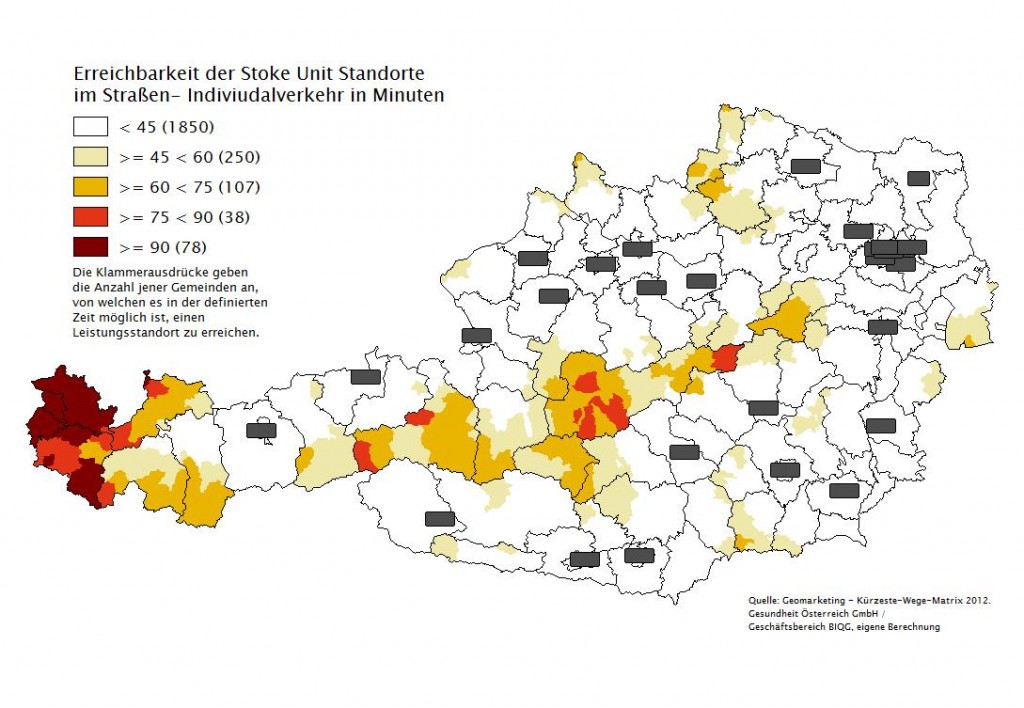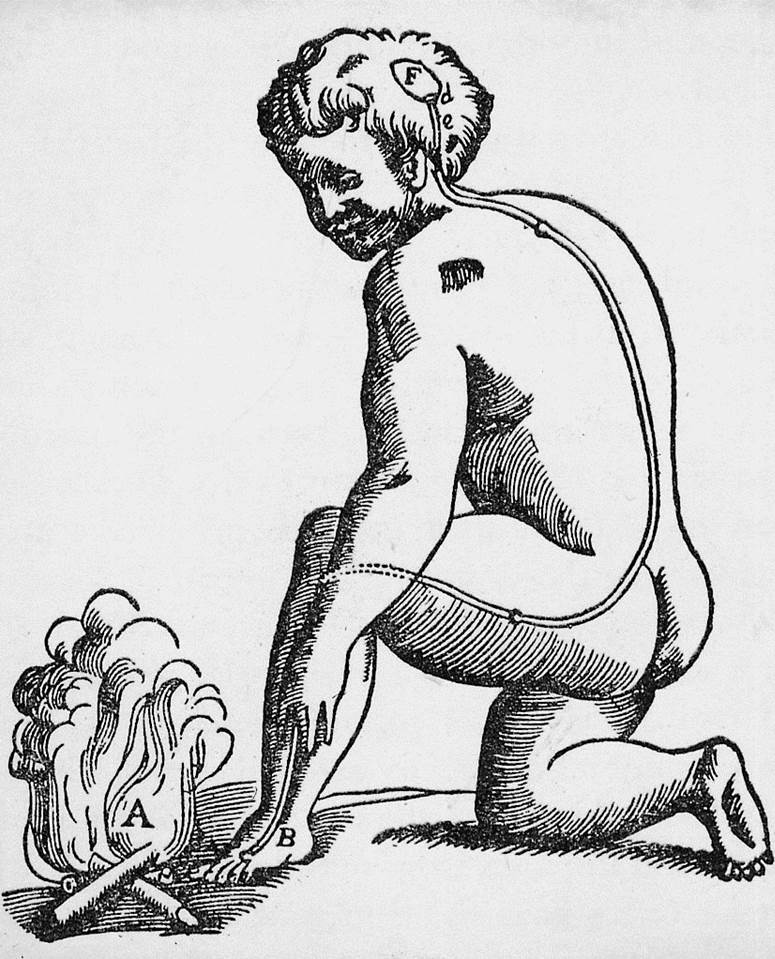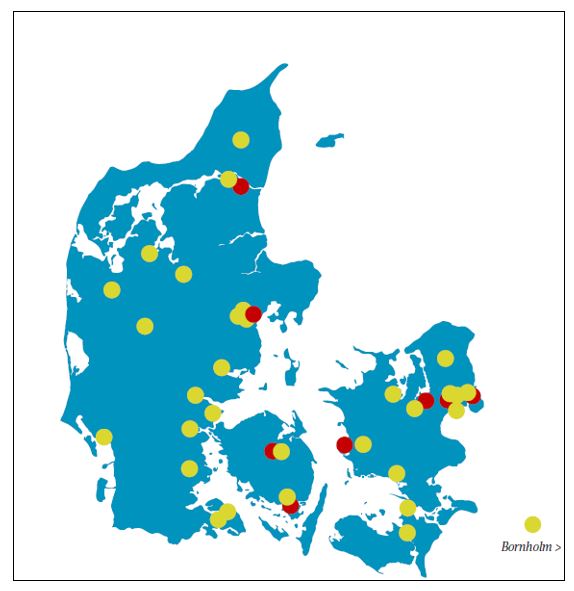 by Julia Ferrari
by Julia Ferrari
Worldwide stroke is the second most common cause of death in developed countries. In Austria the incidence rate of stroke is 2.1 – 2.3 per thousand annually [1,2], implying that a stroke occurs every 26 minutes.
Austria has 8.4 million residents, approximately 84,000km² and 9 provinces. The Austrian health system is a federal system, also financed by the regional government and social security institutions.
Two strategies for the treatment of acute stroke were shown to be effective: first, the use of stroke unit care [3] and second, the application of thrombolysis as treatment for acute ischemic stroke. Austrian law requires the ready availability of both for acute stroke patients. As thrombolysis needs to be administered early after stroke, the availability of comprehensive stroke units throughout the country has been planned at a very early stage (Brainin, Steiner 2003, and Steiner, Brainin 2003). At least 40 stroke units are planned to be available by the year 2015 in Austria. Presently, 35 Stroke Units are functional. The set up of stroke units was planned according to transport times (isochrones) in order to ensure that patients can reach any given stroke unit within 45 minutes.
 Recently the European Stroke Organisation has redefined a European concept for a comprehensive and a standard stroke unit [6]. On the basis of such definitions the ESO has conducted an international expert survey of elements recommended to be available in comprehensive stroke centers, primary stroke centers as well as any hospital ward admitting acute stroke patients on a routine basis [3,4,6]. In Austria, due to predefined structural and process quality markers all stroke units are quite similar. They either fulfill the criteria for primary stroke centers and otherwise the criteria for comprehensive stroke units . The only exception is endovascular therapy, which presently is not available in all stroke units. Another specific requirement in Austria is that stroke units are exclusively established within neurological departments.
Recently the European Stroke Organisation has redefined a European concept for a comprehensive and a standard stroke unit [6]. On the basis of such definitions the ESO has conducted an international expert survey of elements recommended to be available in comprehensive stroke centers, primary stroke centers as well as any hospital ward admitting acute stroke patients on a routine basis [3,4,6]. In Austria, due to predefined structural and process quality markers all stroke units are quite similar. They either fulfill the criteria for primary stroke centers and otherwise the criteria for comprehensive stroke units . The only exception is endovascular therapy, which presently is not available in all stroke units. Another specific requirement in Austria is that stroke units are exclusively established within neurological departments.
From 2003 onward, the quality of Austrian stroke care is being documented by a central institution in the Austrian Stroke Unit Registry. This online registry is monitored by the institution on behalf of the government and its purpose is to guarantee equal quality of care throughout Austria. [7,8]
The Austrian Stroke Unit Registry became the first nation-wide quality assessment project, and was rendered possible by the fact that persons in charge of the stroke units agreed to prospectively document their data without additional reimbursement. This was driven by the enthusiastic response to the creation of such a network as well as the possibility to enable more research. Target values for relevant parameters of stroke care were defined in 2002, in order to achieve transparency and comparability. These parameters included the number of admissions per year, various intervals (such as the time from the onset of symptoms to admission at stroke unit; the time from admission to the first brain imaging or the time from admission at the stroke unit to thrombolysis), the number of ischemic stroke patients who received thrombolysis and complication rates. Every stroke unit is provided with online access to its own data and the possibility to compare their data (online) with anonymous data from other centers. The purpose of such online benchmarking is to achieve uniform high quality medical care over time. The entry of data in the stroke registry was voluntary, but is obligatory from 2012 onward. Annual benchmark conferences are held under the auspices of the Austrian Stroke Society in order to review the performance of the network as well as every single component and to update and improve performance for the next period.
Among specialists of stroke medicine it is a prevailing opinion that the stroke unit system in Austria is one of the best in the world (see Editorial: an acute need for better stroke care. Lancet Neurol,6:571,2007)[5]. In the meantime, a number of high quality publications have reported the effects of performance within the Austrian Stroke Unit Network (in PubMed see under: “austrian stroke unit registry”). It is well noted, that Austria has reached a high overall thrombolysis rate of more than 18%. This partly belongs to a high quality performance induced by benchmarking criteria adaptation.
In conclusion, The Austrian Stroke Unit Registry is a comprehensive and high quality nationwide database on the treatment and care of patients in stroke units. Especially the high participation rates contribute to the value of the data. It seems that the collection, analysis and comparison of outcome results – based on the registry – contribute to quality improvement in the participating hospitals.
Using nationwide outcome quality registries based on a standardised process contributes to quality assurance and improvement.
1. Truelsen et al.: Stroke incidence and prevalence in Europe: a review of available data European Journal of Neurology 2006, Volume 13, Issue 6, pages 581–598
2. Brainin M, Dachenhausen A, Steiner M: Wiener Medizinische Wochenschrift, January 2003, Volume 153, Issue 1-2, pp 3-5
3. Leys D, Ringelstein EB, Kaste M, Hacke W for the European Stroke Initiative (EUSI) Executive Committee: Facilities available in European hospitals treating stroke patients. Stroke 2007; 38: 2985-2991.
4. Ringelstein EB, Meckes-Ferber S, Hacke W, Kaste M, Brainin M and Leys D for the European Stroke Initiative (EUSI) Executive Committee. European Stroke Facilities Survey: The German and Austrian Perspective. Cerebrovasc Dis 2009; 27: 138-145
5. An acute need for better stroke care. Lancet Neurol. 2007 Jul;6(7):571.
6. Ringelstein EB, Chamorro A, Kaste M, et al for the ESO Stroke Unit Certification Committee. European Stroke Organisation Recommendations to Establish a Stroke Unit and Stroke Center. Stroke (in press)
7. Steiner M, Brainin M, for the participants in the Austrian Stroke Registry for Acute Stroke Units. The quality of acute stroke units on a nation-wide level: the Austrian Stroke Registry for acute stroke units. Eur. J. Neurol. 2003;10(4):353–360.
8. Brainin M, Steiner M: Acute stroke units in Austria are being set up on a national level following evidence-based recommendations and structural quality criteria. Cerebrovasc Dis 2003; 15 (Suppl 1) 29-32
Julia Ferrari is neurologist working at the Department of Neurology, KH der Barmherzigen Brüder in Vienna, Austria.






